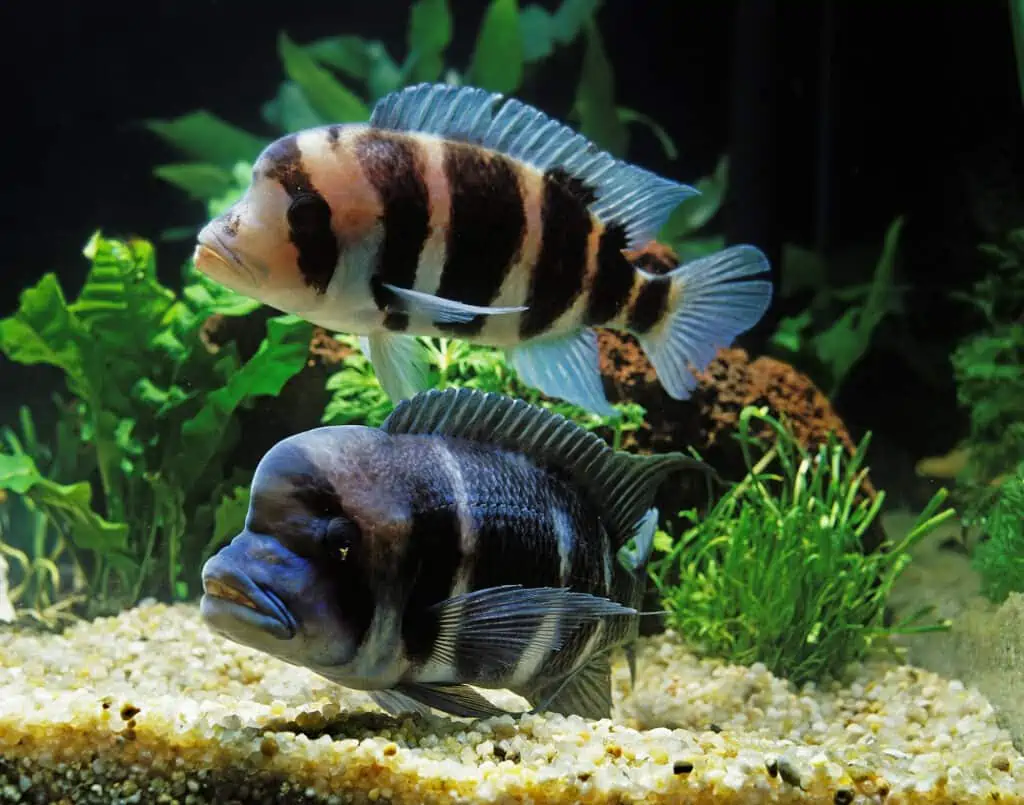The Frontosa cichlid is a beautiful fish to have in any aquarium, particularly a large home aquarium. A stunning freshwater fish that comes with beautiful colors and a cool-looking humped head, they’re a firm favorite of many aquarium enthusiasts, but they require experienced care.
In this article, we cover everything from its origin, expected lifespan, recommended tank mates, diet, and water specs, to ensure you’re taking the best care of your new pet!
| Frontosa Cichlid Info | |
|---|---|
| Minimum Tank Size | 75 Gallons for one, 125-150 for a group of 4-6 |
| Temperament | Semi-aggressive |
| Diet | Carnivorous |
| Temperature | 23.5°C - 26.5°C (74-80 deg F) |
| pH | 6.0-9.0 |
Origins
The Frontosa cichlid is a relatively expensive breed, not usually found in pet stores. This is because they’re quite difficult to come across in the wild due to their love for deep waters and the fact that the only place they have been found is in just one lake.
Originally discovered by scientists in 1906 in Lake Tanganyika, East Africa, they preferred deep water in the lake and were found mostly at depths of 30 – 120m, making fishing them very difficult. Since then, searches for them in other areas have taken place, but they have yet to be found living elsewhere naturally.
That being said, Lake Tanganyika is huge. Although the Frontosa only inhabits the Northern half, it is home to one of the world’s most diverse collections of cichlids. This lake stretches across Burundi, the Democratic Republic of Congo, Tanzania, and Zambia.
So if you’re looking to acquire a wild-caught Frontosa, expect to be paying top dollar for it!
Natural Habitat
Frontosa are native to the northern half of Lake Tanganyika, Africa’s rocky habitats and have a preference for deep waters.
This habitat is dark, deep, and desolate, with minimal plants and vegetation. It’s a great habitat for a predator such as the Frontosa cichlid, albeit quite a difficult one to replicate well in captivity.
Are Frontosa African Cichlids?
Technically, yes. The Frontosa cichlid is actually a type of African cichlid since, you guessed it, they originate from Africa!
When researching this species to find care guides and appropriate information relating to your fish, it’s better to look for information about Frontosa alone, as the care guidelines for African cichlids are less specific to this breed.
Appearance & Frontosa Cichlid size
The rate at which a Frontosa grows is incredibly fast, and before you know it, it can reach up to an incredible 15 inches in length. This isn’t the case with females, though, so if you have one of those – don’t panic! It’s normal for females to average a length of 8 to 10 inches.
For your fish to reach their maximum growth potential, it must have the correct tank size, care, water parameters, and diet to ensure a happy and healthy fish.
Frontosa cichlids are a type of humphead fish, meaning that they have a large lump at the front of their head made up of fat deposits, leading to them receiving the popular nickname – “The Humphead Cichlid.”
This hump grows with the fish’s age and is a good determiner when identifying the dominant males of the species.
Frontosas have very powerful and compact teeth, which can be seen to protrude from their mouths and are an excellent feature of this predatory fish.
Mature males have long dorsal and pectoral fins, which end in what appear to be almost strings. The older the fish becomes, the darker in color it becomes and the longer its fins grow too!
Frontosas are a cichlid that comes in various colors; these types are each unique, with the most common similarity being a blue tone; the prime exception to that, however is the Red Frontosa cichlid.
The Red Frontosa Cichlid
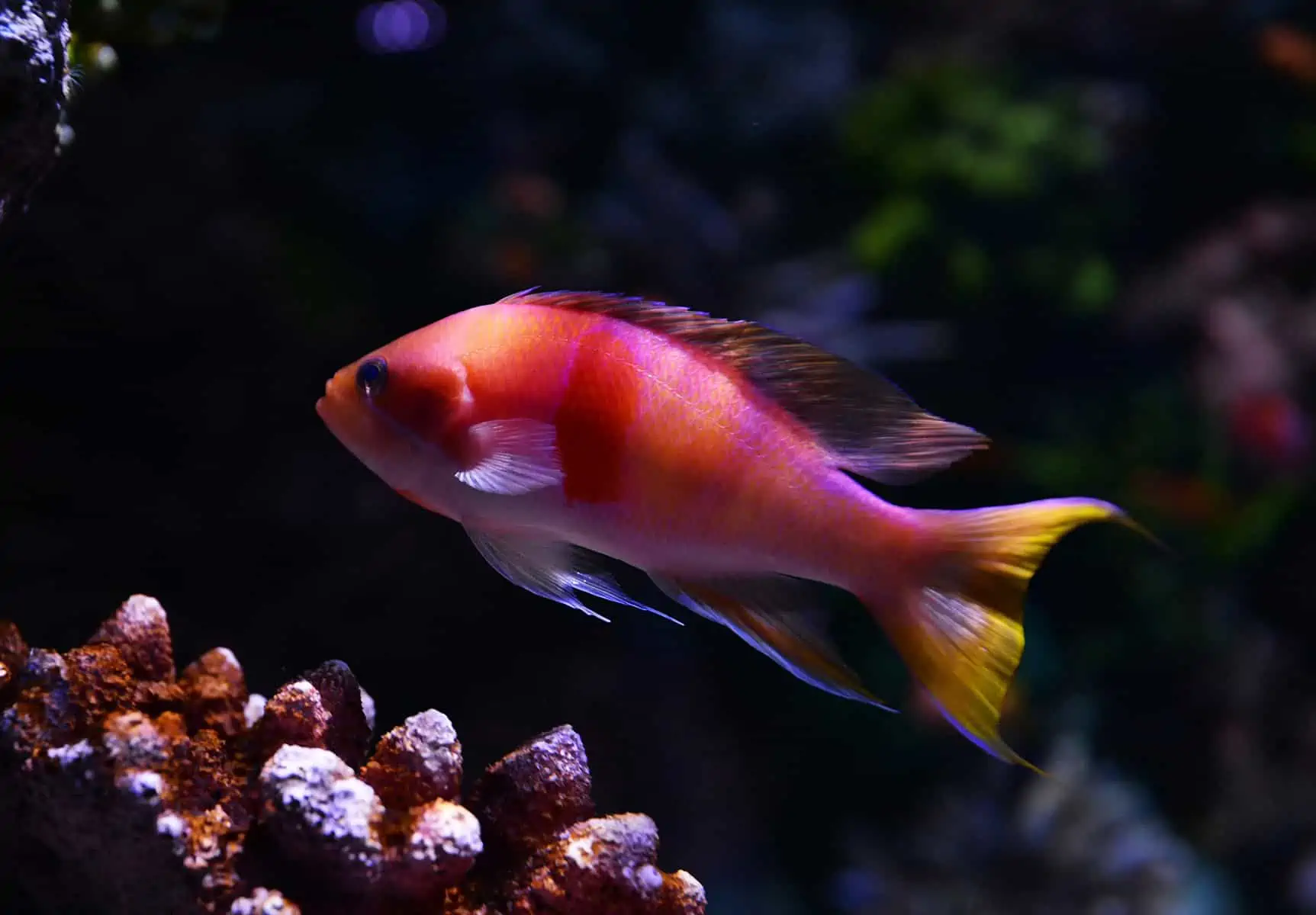
Though the Red Frontosa is still part of the same Frontosa cichlid family, it’s important to note that it has both a different color form to most and a different lifespan.
The Red Frontosa lacks organization in its DNA, a mutation that causes its reddish-brown stripes, unlike the black vertical lines seen on others.
These fish are known to be a descendant of the Taiwan-bred Frontosa species and are not typically found in the wild.
Burundi
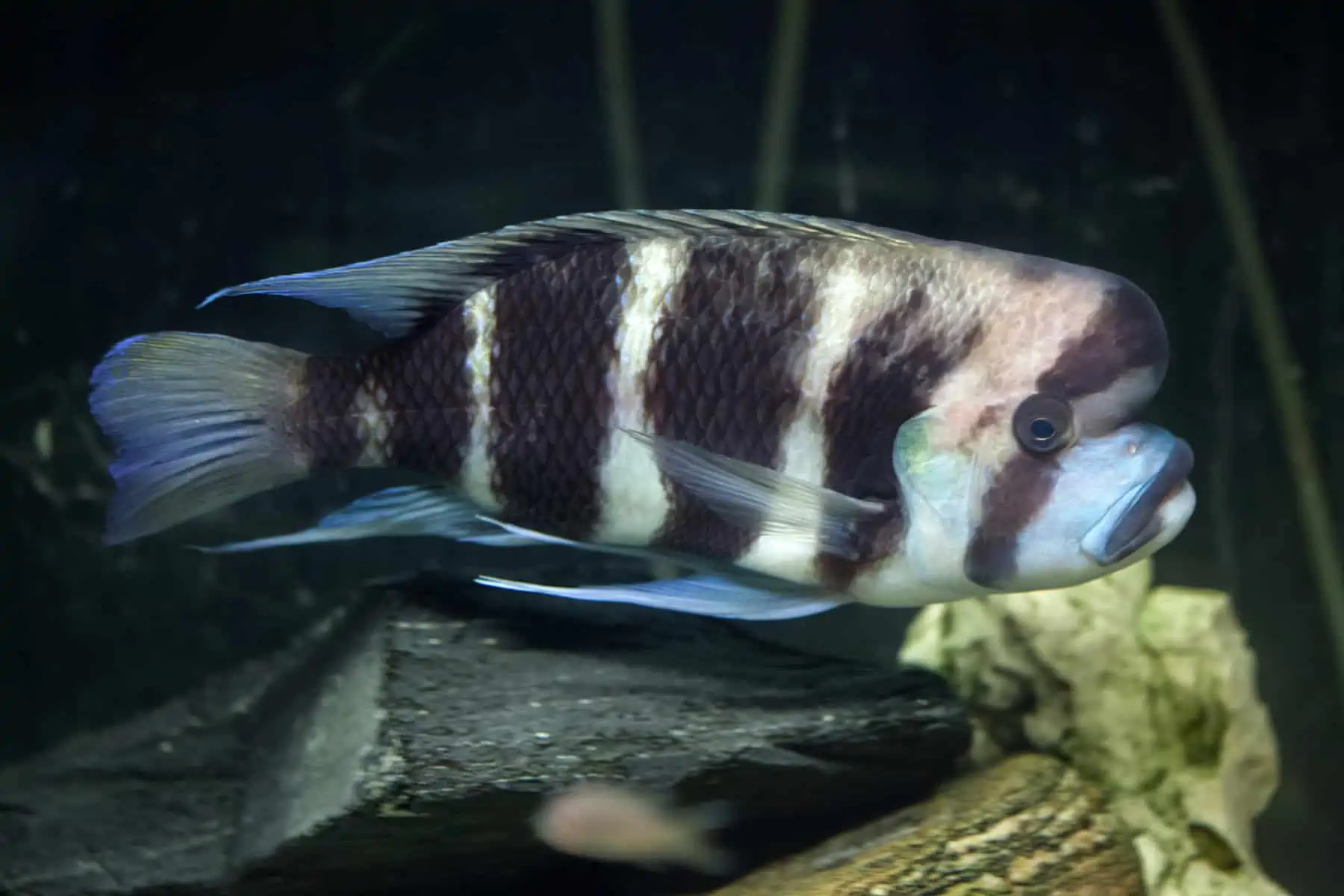
The Burundi Frontosa is the most commonly found hump head species in aquariums worldwide today.
It has a pale blue body with five stripes that run vertically down its back, with the sixth stripe running from its forehead, along its eye, and down below its jaw.
Blue Zaire
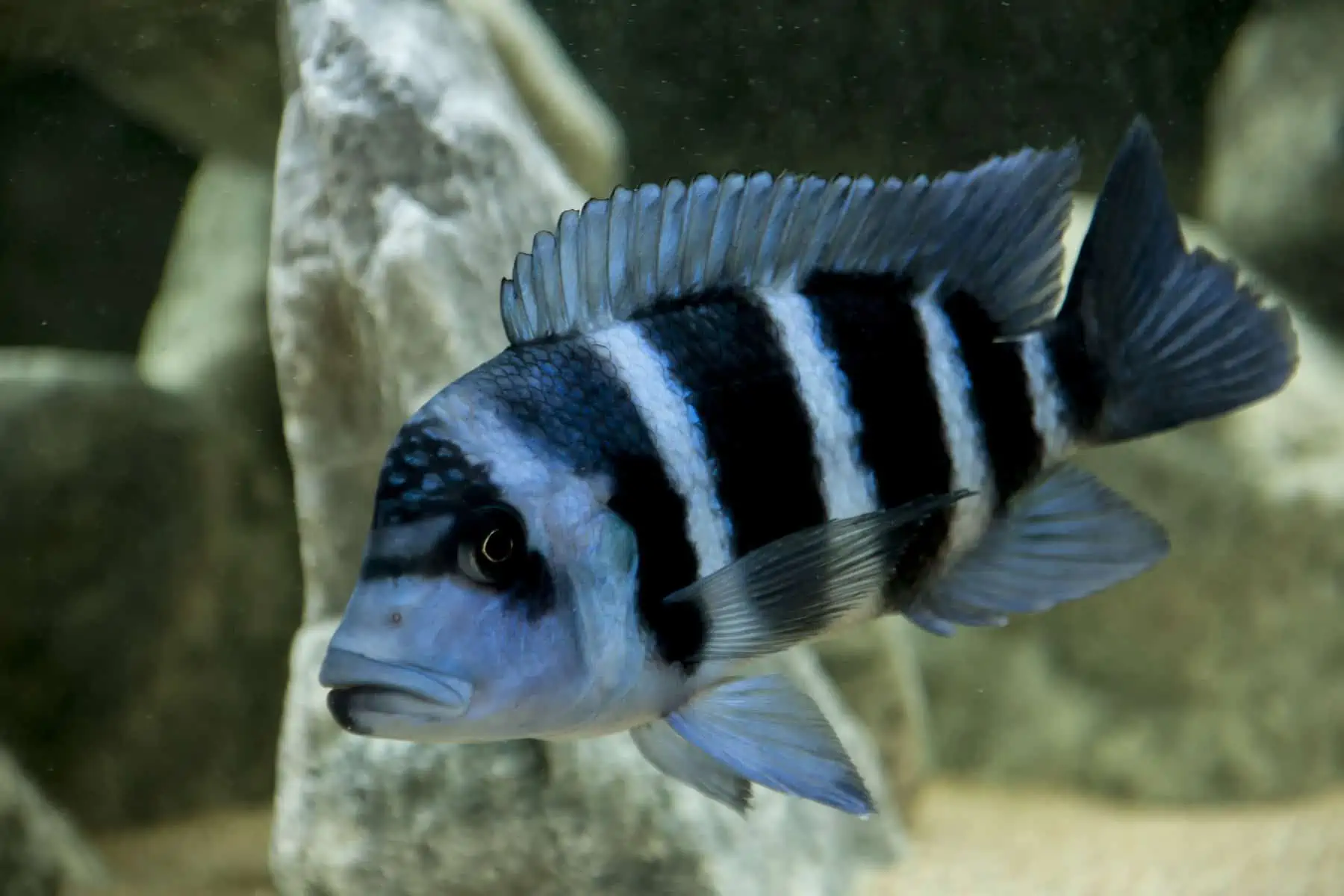
Blue Zaire is an interesting variant, with a blue or white base color and six to seven black bands. Interestingly enough, they can sometimes be found with gold accents on their dorsal fins, making them unique! Overall, this colouration can result in their deep blue/purple look, which only adds to their stunning appearance.
A very rare fish, the Blue Zaire Frontosa cichlid is the most sought-after of its species today.
Why Are Frontosa Cichlids So Expensive?
Due to the political situation in Africa, some parts of lake Tanganyika are not accessible to collectors, making the acquisition of this fish very difficult due to its very small area of origin. This issue, paired with the fish in such deep waters, makes them incredibly difficult to catch in the wild.
A wild-caught Frontosa can be incredibly expensive, but high-quality breeders can also be very expensive.
That said, as with anything, you get what you pay for, and if you find a Frontosa at a price that looks too good to be true, that is likely the case. Be sure to research the breeder, and if possible, find out the background of the fish, to ensure you’re not purchasing one at a low price due to genetic defects or illness.
Are Frontosa Cichlids Aggressive?
Before we answer this, it’s important first to point out that no matter how docile your Frontosa may seem, do not, under any circumstances, house him with a tank mate less than 3 inches. Even if he’s super friendly, he could easily mistake a little new friend for a snack!
Frontosa’s are semi-aggressive fish, but as far as cichlids go, they’re typically quite mild-mannered compared to other types. They can get rather territorial and sometimes aggressive, particularly during breeding.
To keep this temperament in check, you’ll want to get a tank big enough for all your fish to have their own space (helping to prevent territorial disputes) and plenty of hiding spaces for your fish to retreat to when they need their own space.
It can be quite easy to tell when a Frontosa is stressed, as its colors will become darker and less vibrant.
Care Tips (Grouping & Housemates, Breeding, Diet)
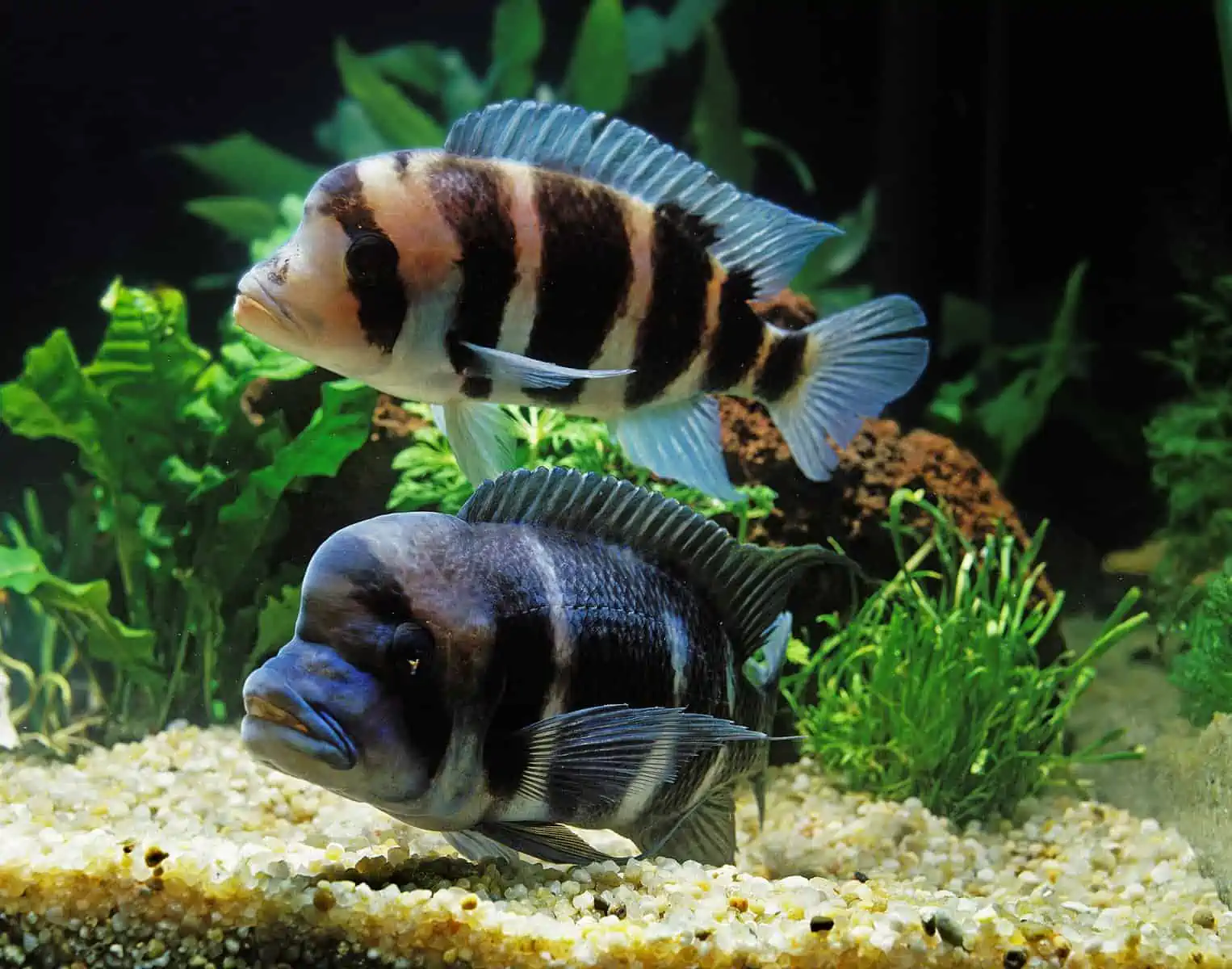
What Fish Can You Put With Frontosa?
Whilst Frontosas are likely to get along well with many types of fish. The real issue is finding tankmates that will thrive in the same hard water conditions they require. For this reason, they’re almost always housed with other rift lake fish.
If you’re considering finding a good housemate for your cichlid, you might want to consider one of the following:
- Central American Cichlids*
- Cuckoo Catfish
- Larger Rainbowfish
- Medium to Large Rift Lake Cichlids
* Be careful when choosing to house your Frontosa with Central American cichlids. These are likely to be more aggressive than Frontosa. Larger species, such as the Jaguar cichlid, can be even too much for a male Frontosa to handle, but some slightly smaller ones, such as Jack Dempsey cichlids, are far better choices.
You also must be careful not to choose large fish which may not be able to handle the same water conditions. Many larger fish species are from South America and Southeast Asia and do not do well in extremely hard, alkaline waters.
Some examples of fish that shouldn’t be housed with Frontosas include:
- Barbs
- Gouramis
- Large South American Cichlids (such as Oscars)
- Livebearers*
- Silver Dollars
- Tetras
* Livebearers would seem a great choice, given the water conditions specified for the Frontosa’s tank. However, all livebearers are generally far too small to avoid being a potential snack for your Frontosa. Larger Sailfin mollies may just be okay, but it’s a risk I still wouldn’t recommend taking.
Breeding
Sexing
Frontosa’s are not the easiest cichlid species to tell males apart from females.
Females, just like males, can have a stocky appearance and are no less colorful. Whilst they are young, they can be almost identical until they reach sexual maturity at about 3 years old. At this stage, males will have developed a prominent nuchal hump and will likely display fins with longer extensions or ‘strings.’
Frontosas can be very selective when it comes to mating, so instead of just putting two fish together in a breeding tank and hoping for the best, raising a harem is more effective if you’re looking for successful breeding.
The best way to do this is to raise a group of young Frontosas, starting with around 10-12 young fish. As these mature and you can tell which are male and female, you should remove the males until you’re left with just one or two (dependent on the size of your aquarium, of course). Then you will want to leave the females in the tank (depending again on the size and how many it can comfortably hold).
In the wild, the harem’s typically composed of one male and 4-6 females with whom they will breed.
Conditioning & Raising fry
Once your Frontosa harem reaches adulthood, breeding is pretty much inevitable. As the natural habitat of Lake Tanganyika has such stable conditions, you won’t need to do large water changes or temperature adjustments in order to stimulate spawning, and it should just happen naturally within the tank.
Providing your fish with fresh, meaty whole foods is important in reproduction. This is because the female will not eat for the first month after the eggs have been fertilised, so she will need ample fat stores to ensure she is kept healthy whilst incubating her babies.
The male and female will embrace and fertilise the eggs, and then, once fertilized, the female will scoop them into her mouth to incubate them and keep them safe from predators. This is because Frontosas are a type of mouth brooder, similar to most rift lake cichlids. During this incubation time, the female will not eat, focusing her attention on keeping her unborn babies safe.
During hatching, the female will release them, where they form a sort of cloud around her head, and the male will stand guard, keeping an eye out for predators.
If either parent notices any chance of danger, they will signal for the fry to seek safety, and they will dart back inside her mouth – the closest and safest place possible. As Frontosa are predators themselves, it’s likely that if the fry could be eaten by anything, their parents would be able to eat it.
In terms of what they eat, however, they’re quite large compared to many other baby fish and are around half an inch long when they’re newly hatched. This means they can readily eat any food you offer to small fish, such as brine shrimp, flakes, and other small items.
At around 40-50 days after hatching, the fry becomes increasingly independent and will begin to move around of their own accord and do their own thing, wanting to leave home, go to university and get a good job.
Of course, that’s just a joke, but it’s at this age when the fry is too old to need the safety and guidance of their parents, and you should remove them from the main aquarium and house them in a separate tank. As they’re quite a difficult fish to get hold of, you should have very few problems finding them a new home!
Diet
Frontosas are naturally alpha predators, meaning they need plenty of protein to ensure growth and optimum health. Their diet can consist of both live and dead fish, chopped-up shellfish (such as mussels and shrimp), worms, and other meaty foods.
Frontosas don’t feed very quickly, nor do they tend to fight over food as many other fish species do. They don’t compete and can be quite lazy, so if not in a species-only tank, you may want to reach out, offering them pieces of fish or meat with feeding tongs in order to ensure they get their fair share of food.
Fluval Bug Bites are a good choice for anyone looking for a Pellet formula for their Frontosas. Unlike many pellet formulas, they use far fewer wheat and corn-based fillers (these are an essential ingredient in pellets, though, as they act as a binding agent). Instead, these pellets are mostly made up of animal proteins.
Tank Setup (Decor, Tank Size, Water Parameters)
Decor
Many keepers of Frontosas report that their fish are becoming stressed and constantly trying to hide when kept in continuous bright daylight.
This is because they’re deepwater fish, typically found 30-50m below the lake’s surface, sometimes even deeper. For this reason, they don’t receive much light in their natural habitat, so to prevent them from stressing out, you’ll want to keep them in low-light conditions, giving them plenty of hiding space when they get stressed.
Subdues lighting, large caves, overhangs, and places to retreat will ensure these fish feel safe and give them plenty of space to hide. They’re typically quite a shy species, and having an abundance of hiding spaces can help them feel secure and happy in their home.
In terms of substrate, sand or small gravels are generally recommended, with many keepers choosing to use aragonite sand or crushed coral, as these can help buffer the water’s pH levels. The white of the aragonite can also really bring out the deep black and blue colors in the adult Frontosas.
It is also important to note that Frontosas are great at landscaping, and this can often disrupt your plants if you have any planted in the tank, leading to uprooting. They enjoy digging and re-arranging the substrate, even if they are not breeding, and will like to make piles of sand or gravel throughout the tank.
What Size Tank Do I Need for Frontosa?
If you are housing a harem of Frontosa, you’ll likely want a tank size of around 125-150 gallons for 4-6 fish. Any more than this, you’ll want a bigger tank.
For any Frontosa housed alone, you’ll need a 75-gallon tank, any less than this, and the aquarium will be too small and narrow for your fish to move around comfortably.
You’ll also want to ensure that your tank is fitted with a high-powered canister filter to ensure healthy water quality. This is because Frontosas are large predatory fish, meaning they create huge amounts of waste, which is incredibly difficult to take care of if you don’t have the correct filtration set up.
Water Parameters
The Frontosa’s natural habitat, Lake Tanganyika, is the saltiest of all three of Africa’s great lakes. This is likely due to the lake being millions of years older than the other two notable ones (lake Malawi and lake Victoria), meaning that it has had more time for minerals to concentrate and dissipate within it. This makes the water extremely alkaline.
There is also very little variation in temperature and chemistry by season in their natural habitat, so water conditions in captivity should remain stable throughout the year. Aquarium-raised Cichlids can typically be quite hardy, but wild-caught fish can die from moderate changes or shocks, so they should be treated carefully.
The water parameters required for Frontosa cichlids are:
- Temperature: 23.5°C – 26.5°C (74-80 deg F)
- pH: 6.0-9.0
- Hardness: dGH 10 – 20
The Frontosa cichlid is a beautiful and unique aquarium fish, which is fairly easy to raise and maintain, and breeding is not too difficult either!
So long as you provide this amazing fish with ample space, good food, and high-quality water, it will make a great pet or addition to any keeper’s hobby.
These large and stunning fish are already a favorite of many, so if you’re looking for a big fish that’s as simple to keep as a small one, the Frontosa is a great place to start!

